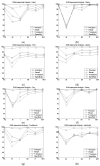Recognition of Daily Gestures with Wearable Inertial Rings and Bracelets
- PMID: 27556473
- PMCID: PMC5017504
- DOI: 10.3390/s16081341
Recognition of Daily Gestures with Wearable Inertial Rings and Bracelets
Abstract
Recognition of activities of daily living plays an important role in monitoring elderly people and helping caregivers in controlling and detecting changes in daily behaviors. Thanks to the miniaturization and low cost of Microelectromechanical systems (MEMs), in particular of Inertial Measurement Units, in recent years body-worn activity recognition has gained popularity. In this context, the proposed work aims to recognize nine different gestures involved in daily activities using hand and wrist wearable sensors. Additionally, the analysis was carried out also considering different combinations of wearable sensors, in order to find the best combination in terms of unobtrusiveness and recognition accuracy. In order to achieve the proposed goals, an extensive experimentation was performed in a realistic environment. Twenty users were asked to perform the selected gestures and then the data were off-line analyzed to extract significant features. In order to corroborate the analysis, the classification problem was treated using two different and commonly used supervised machine learning techniques, namely Decision Tree and Support Vector Machine, analyzing both personal model and Leave-One-Subject-Out cross validation. The results obtained from this analysis show that the proposed system is able to recognize the proposed gestures with an accuracy of 89.01% in the Leave-One-Subject-Out cross validation and are therefore promising for further investigation in real life scenarios.
Keywords: activities of daily living; gesture recognition; machine learning; sensor fusion; wearable sensors.
Figures







References
-
- European Commission (DG ECFIN) and the Economic Policy Committee (AWG) The 2015 Ageing Report for Underlying Assumptions and Projection Methodologies. European Economy; Brussels, Belgium: 2014.
-
- Moschetti A., Fiorini L., Aquilano M., Cavallo F., Dario P. Ambient Assisted Living. Springer International Publishing; Berlin, Germany: 2014. Preliminary findings of the AALIANCE2 ambient assisted living roadmap; pp. 335–342.
MeSH terms
LinkOut - more resources
Full Text Sources
Other Literature Sources

